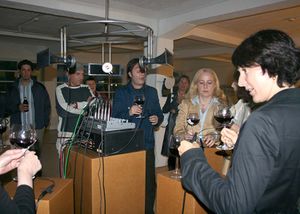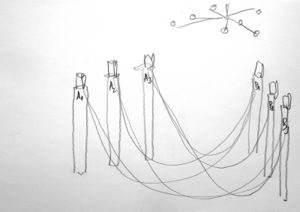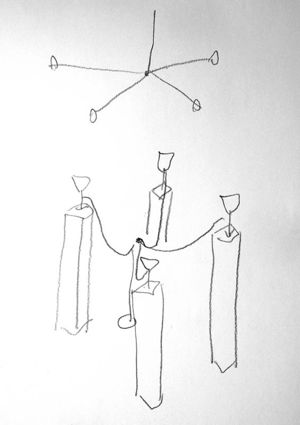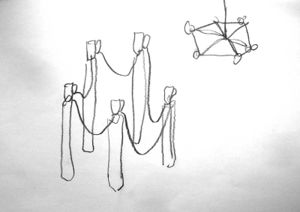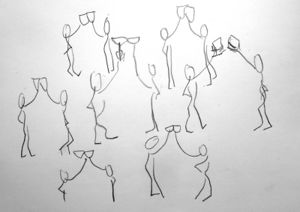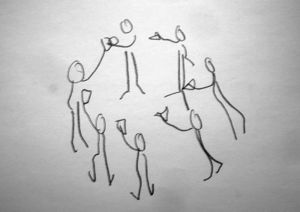Clegg and Guttmann
Aus Daimon
Konzept der Installation Five Toasts für die Ausstellung Die Dämonen.
FIVE GENERIC TOASTS
Elementary Forms of the Collectivist Spirit
Introduction
Five Generic Toasts is an art installation to be presented by Clegg & Guttmann or, using their own terms, a group of cognitive exercises around the theme of social toasting. The work is an essay of sorts on this wide spread habit of clicking vessels filled with alcoholic drinks as a token of celebration, commemorations of special occasions and, above all, as means of establishing a momentary sense of solidarity among a group of participants.
Five Toasts contains a variety of related but separate ‘toast stations’ where members of the audience may collectively experiment with different versions and variations of the social habit of toasting and, in doing so, reflect on the general conditions for the emergence of a sense of solidarity and unity of purpose. Each invites a determinant number of participants to carry out together a cognitive experiment designed to heightened awareness of this elementary ritual of human togetherness.
The different components of the work
Each of the ‘toasting stations’ is a particular set up for conducting toasts; the stations will use different drinking vessels - mugs, tumblers and wine glasses - containing different alcoholic beverages - beer, wine and vodka - which the participants will toast in a number of particular styles. Among the physical elements of the installation are pedestals and other wooden structures, glass vessels, chandeliers, straps and elastic bands, a floor drawing and various texts and inscriptions that explains the rules of the different cognitive exercises.
In addition, the work will also include a number of video tapes to be beamed on the walls of the space where actors are seen reading a variety of texts related to the topic of toasting. The habit of clicking glasses in unison has, indeed, many different facets; it may explored from the physical, cognitive, philosophical, anthropological, mathematical and sociological points of view.
On the accompanying documents
We include a number of schematic drawings of various parts of the Five Toasts installation. A group of more precise floor plans and technical drawings will follow shortly. We also include a more general philosophical text on the ideas we aim to explore. Five Toasts is still a work in progress and, currently, the best way to present it is to provide the general plan behind it together with the intellectual framework thereof.
FIVE TOASTS
Elementary Forms of the Collectivist Spirit
An Essay by Clegg & Guttmann
Part I: An Introduction
Specific vs. generic toasts
The practice of toasting or, bringing drinking vessels into physical contact in a predetermined and coordinated manner, - mostly glasses containing alcoholic liquids - is intended, most commonly, as means for celebrating or commemorating specific noteworthy events - birthdays, engagements, professional milestones etc.. Deceptively simple, these practices are, none the less, far from uniform and the meaning attached to them, varies. Some cultures deem only celebrations toast-worthy whereas others, solemn occasions, as well. In certain contexts the practice conveys gratitude to a higher force whereas in others, only vicarious pleasure and contagious joy. Such variations are to be expected; specific toasts, to coin a term, reflect a logic of shared happiness and the latter is, notoriously, culture-specific. Generic toasts, by contrast, which are not tied to specific events, are widely regarded as rituals of togetherness. The latter constitute a distinct category and, for reasons we shall outlines shortly, the meanings attached to its members are markedly less diverse. When the toasters merrily touch their glasses without invoking, as a reason, specific events, they do so invariably as an acknowledgment of their membership in the group, a tribute to their bonds and, the social space that envelopes them all - the stage of their inter-connected actions. At present, our interest lies, primarily, in the analysis of the collective spirit and, the concept of group identity; for this reason, we shall be concerned, first and foremost, with practices that belong to the category of generic toasting.
Generic toast as a bridge between individual experiences
The near universality of the meaning assigned to generic toasting is not altogether surprising. The toast marks a moment when physical contact was made between a number of distinct independent entities, furnishing an indication of their literal closeness at some determinate point of time rather than, mere symbol thereof. The clicking of the glasses, moreover, is a shared event, namely, one represented in the frames of reference of the different participants. Such events bridge the experience of the members of the group. Appearing `simultaneously` in the `streams of thought` of different subjects, the toasting may help them to `glue together` their separate worlds - place them all in one and the same living space.
The epistemic benefits of a coordinated act
The potential epistemic benefits of coordinated acts like toasting are important and easy to appreciate - the members of the group may use the timing of the toast to `synchronize their watches` and its location as a spatial reference point. In turn, the agreement over the reference to points of time and space may help the diverse subjects to institute an inter-personal system of measurement; it allows the subjects to communicate to each other that something happened in the vicinity of that point in space or in a certain distance therefrom. It also allows the participants to communicate that certain events happened approximately the same time as the toast and, once clocks are instituted, after a certain interval of time. Setting inter-personal standards of measurement of space and time, the participants can then define an `interpersonal space` where they all belong. Once common standards and methods of measuring are established, the respective experiences of the different members may be presumed comparable or, what amounts to the same thing, possible to embed within a single overarching inter-personal space-time that contains them all.
The Coordination of Reference
The event of toasting implicitly involves the `baptism` of an indexical term designating a unique spatiotemporal point, (i.e. the moment and the place where the glasses made contact.); the sense of the term, namely, the manner in which the events related to its introduction, appeared in the streams of thought of the individuals involved - differs, naturally between one individual and another; the reference, though, - the space-time point itself, - is presumably assigned in the same way by all the members of the group. The case of toasting is not an isolated one. The category of coordinated acts offers a wealth of paradigmatic cases that clarify the process whereby inter-subjective terms are introduced into the language and explain how inter-personal communication may be possible between a multitude of human subjects who recount their experience to themselves in a variety of different ways.
The practice of ostensive definitions
More specifically, there is much to be learned from the case under consideration about a procedure known in the philosophy of language as ostensive definition, namely, communicating about an object without referring to it by name but, pointing or calling attention to it by other means. The literature on the subject is vague on the necessary and sufficient conditions that guarantee such mode of reference with success and thus a study of concrete cases, where terms are introduced into the language through a concerted and well rehearsed group effort, has much to recommend. Indeed, the slightest attention to the details of the case at hand reveals what is involved in fixing the reference of terms with an ostensive definition.
(i) Usurping attention - Ceremonious toasting commands the attention of all those involved. For the duration of the toast, the coordinated act the members of the merry group are engaged in is expected to occupy the entire horizon of their respective experiences. Let us not mince words here - during a short interval of time the participants` attention is usurped; the toasters must suspend their freedom of thought temporarily - a personal sacrifice for a common good.
(ii) Pre-designated focus - Every one of the toasters is expected to single out and register where his hand, carrying his glass, sensed resistance from vessels held by others. That feeling defines the timing and the location of their momentary spatial coincidence, namely, the reference of a term they labor to introduce into their language.
(iii) The importance of multiple independent indicators - The participants must register also when a clinging sound impinged on their ears - an independent indication of the general location and the timing of the event. The possession of two independent indicators that coincide is crucial for the ability to refer to an external object; the first indicator functions as means to attract attention to the latter whereas the second, as a non-trivial attribution to it of spatial and temporal location.
(iv) The `soldiering` of the manifolds - The payoff is considerable; the diverse streams of consciousness are thereby connected in that one point of space and time! That is what we mean when we say that the toasting bridges together the separate experiences of the participants. There is nothing mystical about such processes; a moment of usurped attention and mutual awareness is all that is required for such a fit.
Referential coordination and group identity
People who wish to communicate general statements about a shared event may rely on the fact that all of them were present together in a point in space at a certain moment of time, interacting with one another and registering internally the impact of the same forces. Such general considerations are not, however, sufficient as guarantees of the convergence of the references of singular terms. The key to the successful introduction of an ostensible definition of such terms is ascertaining that each and every one of the participants focuses on exactly the same event. Everyone present must be reassured he is pointing to the same point of time and space as everyone else and nothing short of absolute consensus on this issue will do.
The energy exchange between the toasters when their glasses made contact is ideal for the purpose of referential coordination. The transfer of momentum with other bodies - something each of the toasters sensed individually during the event - is not a collection of separate events whose identity is open to question but a single one involving all. If one lost energy, someone else or, a number of them, must have gained it. There were no two events whereby one lost energy and other consequently gained it but one relational event where both things happened at the same time. This is the meaning of the first law of Newtonian mechanics; action and reaction are two sides of the same event rather than two correlated but separate ones. For this reason, the convergence of the assignment of reference to a term designating a spatial and temporal point is guaranteed when a momentum transfer from one object to another took place therein. Such an event may connect to each other a number of bodies - as it is the case when a toasting takes place - and thus, when they use it in an ostensive definition, they may all rest assure they are referring to the same point in time and space. Toasting, in a word, may be regarded as an event that determines a spatial and temporal point uniquely. Alternatively, the toasters may focus on their interactions with each of the others, negotiating, individually, a `treatise of reference` with everyone else. Indeed, in some types of toasts each of the participants exchanges energy with each of the others, separately. Doing so is also a sufficient guarantee for an entire network of interpersonal points of contact to emerge, connecting to each other the manifolds of experiences of the participants. The coordinated cognitive focus of the group of toasters acts like an inter-experiential connection that `pins` together, like sheets of paper, different individual manifolds of experience, `perforating` each where the moment of toasting was marked. The successful baptism of a new term by a group of individuals has immediate social consequences. In a fairly literal sense, a collective treaty on the coordination of reference or, the pairwise negotiations between the individuals involved, create a community of speakers out of a multitude of separate beings.
The toast as a socio-cognitive ritual
In the case of toasting, the processes involved in `baptizing` indexical terms are carried out gratuitously. In reality, terms of the aforementioned kind that designate the specific location and timing of the toast are rarely employed thereafter for purposive communicative aims; rather, the toast seems designed to reminds the participants that establishing terms with interpersonal reference is not be taken for granted. Referential coordination, to coin a term, requires institutions established. Individuals who wish to affirm to themselves their group identity must, at the very least, engage in coordinated activities of one type or another and when the latter are articulated abstracted and repeated they become institutionalized. Because of the gratuitous nature of the coordinated baptism during the toast, these acts, themselves, are made objects of observation and reflection. Indeed, in a certain sense, toasting is a ritual of coordination of reference and not a genuine act of baptism carried out for communicative purpose. During the toasting, the participants are reminded of these facts; when they carry out, gratuitously, procedures ordinarily used to facilitate communication and agreement they become aware of an element of social ritual implicit in all such activities. Toasting, in a word, underlines the fact that a certain social presupposition underlies every epistemic practice that requires inter-personal agreement; it must be assumed that a basic inter-personal framework has already been put in place. In particular, in order to presume that the different subjects assign the same reference to terms they use to designate various aspects of the separate experiences, the latter must be, first, bridged. In order to exchange ideas, in other words, the different subjects must be placed together in one and the same world.
Both, the need for a fundamental `social hypothesis` and, the means of satisfying it, are highlighted during sessions of toasting. When they perform acts seemingly designed for the baptism of a term, without actually paying much attention to the practical benefits of the procedures, they are in a position to observe how carrying them out has transformed them from a mere collection of individuals to an amalgamated social entity. The awareness of the by-products of their coordinated actions, in other words, provides them with an insight into the meaning of the aforementioned `social hypothesis`. They become aware that social togetherness is a tangible condition even when it has no further consequences. Something in the world changes when a number of distinct individuals find their collective social space even before any consequence of their new condition becomes actualized, namely, before connections are actually established.
Toasts reveal how simple and benign are the actions we commonly undertake in order to establish a collective frame of mind - they demystify the social hypothesis. There is, indeed, nothing supernatural or ominous in the state of mind of the merry toasters. Togetherness among them merely means they acknowledge each other`s existence and, observe each other`s actions, as matters with potential significance to their own. On the other hand, the force of the social connections created should not be exaggerated; the toast, in and of itself, does not engender unconditional sympathy among the participants nor transform them into a stable social group; the toasters, to repeat, merely undertake a ritualistic exercise in collectivism and institution-building. During the toast, the possibility of arriving with others into a state of social cohesion is vividly presented to them. Rather than actually forming a social alliance, they merely acknowledge that doing so is possible and that bonding with others is something with potential importance to their lives.
Be it gratuitous as it may, the state of superposition the individuals toasters enter into has the effect of creating a momentary sense of togetherness. Each of the participants must open up a door into his or her private inner sphere, allowing the rest to walk in, as it were, and present themselves, individually.
Sensus communis
Kant dubbed the ability to form a concept of a community of cognitively like-minded beings sensus communis or, common sense. The term common sense might reflect a capacity the members of one`s cognitive community are all endowed with or, alternatively, something they gained when they elected to form themselves as a community. As we shall see next, the same ambiguity between the cognitive and the social is present in one form or another whenever we discuss concept formation and judgment.
The cognitive aim of the subject is to faithfully represent conditions external to him and, with this aim in mind, he must free his mind from the influence of anything idiosyncratic in his thinking. Any impression or, aspect thereof, whose origin is internal must be regarded as a subjective noise rather than, objective representation. The weeding of idiosyncrasy, in other word, is, first and foremost, a cognitive requirement. However, when he lets go of any subjective disposition, thereby convincing himself his cognition furnishes a clear channel to the external environment, the subject also clears the road towards agreement with others i.e. the possibility of consensus and convergence of opinion; doing so, in a word, is an expression of a social side of his being. Like king Saul, trying to find a horse, he found, instead, a kingdom. When all the subjective `noise `has been disposed of, and everyone directed himself towards the objective world, the subjects discovered they thereby founded a community where inter-personal cognitive agreement may be presumed or, their sensus communis. Aiming to satisfy the requirements of objectivity, they acquired reasons to believe in the possibility of agreement with others.
Do superpositions `linger on`?
One of the more obscure and less accessible aspects of our discussion about the concept of superposition concerns the duration of states of that kind or, more generally, the typical time scale, involved. Here, questions shoved aside earlier like whether the concept was primarily mathematical of physical come back to haunt us. Certainly, we may initially stick to the glib `party line` and maintain, as so many theoretical physicists do, that there was no need for precise demarcation between the fields, that the intellectual home of concepts like superposition was mathematical physics - a highly fruitful field combining both. But once states of superposition are defined and applied to physical states in contra distinction with their addition, conjunction, disjunction etc., the question arises whether the operation lingers or not.
Resonance
In fact, the actions of the toasters reflect togetherness and unity of action in much more direct and literal sense than the one so far discussed. As a result of the contact between the glasses of the toasters, the latter oscillate together - pulsate in the same frequencies. Even more remarkable is the fact that, when less than perfect examples are concerned, the sounds emitted by the toast are nearly perfect indicators of the measure of the unity of the different participants; the more harmonious the sound, the greater the correlation. Even the temporary nature of the contract of unity signed by the toasters receives an astonishingly accurate audible expression; the curve of its eventual dissolution is perfectly plotted by the dampening of the vibrating sound.
Part II: Five Generic Toasts
(i) The `One to All` toast. A company of six drinkers who hold small tumblers of vodka gather together in the form of a circle. Muttering something in unison, they raise their glasses, bring them forth towards their common center and smash them together loudly, setting their liquids in turbulent motion. The waves continue before subsiding; echos of a moment when all the members of the group have made spatial contact thus lingers forth in time, preserved for a while longer after the vessels have been separated from the rest. Strictly speaking, each of the glasses hit only two of the six. But the communal smashing of the glasses had an correlated impact on each and thus deserves to be considered a meeting of sorts that made a coordinated group of the separate individuals. Besides, a contact of an indirect kind has been established between each and the rest. Lack of exact and detailed knowledge withstanding, the toasters assume their collective action established a chain connecting each of the lot to each of the rest through the offices of a determinate but unidentified third attached to both. The manifold physical contacts undertaken during the toast were deemed implicitly by all sufficient for the purpose of bringing upon themselves a state of superposition.
(ii) The wave. The beer drinkers, too, are organized in the form of a circle. But, because they are more numerous, they let go of pretense and have each of the toasters bring his mug into contact only with the one on his left. A wave of successive toasts is thus formed that is presumed to satisfy the requirements of superposition. The wave procedure has much to recommend it as means for ascertaining that the members of the group have joined together; each of the toasters is connected to each of the rest in a 1-chain, 2-chain 3-chain etc.
(iii) The Tournament Toast. A different group of drinkers is toasting with large balones rouge. This time, each pair among them establishes contact separately. The number of contacts required is given by the following `tournament formula` that determines the number of games necessary for matching each pair once in a league of n players.
(§) The Tournament formula: The number of matches in a league of n players is n2-n/2.
Proof: To see why the formula gives the correct results imagine each pair listed in an n by n matrix where the first row pairs the first element with each of the rest, in the second row the second element is so paired, the third row pairs the third element etc. The diagonal contains items with the same individual named twice. It does not therefore represents legitimate pairing. Moreover, lying symmetrically on either sides of the diagonal are two pairings containing the same elements, ordered differently. The items lying on either side of the diagonal will thus suffice. It follows then that we must subtract from the n2 items presented in the matrix n that lie on the diagonal and divide the rest in two.
Accordingly, the case at hand comprised of 15 separate individual toasts.
(iv) A Champaign Toast. A number of merry toasters raise their respective flutes without actually bringing them to touch one another. They look at each other intently, each pair sustaining an eye contact for an appreciable duration. The entire procedure required five successive stages; the six were divided, each time, into three different pairs of `deers in the headlights`. In this manner, each was given an opportunity to negotiate a treaty of temporary superposition with each of the others. This set of acts, too, was deemed sufficient. When the ritual was completed, the participants carried in their respective minds different images of the same crystalline form that described abstractly the structure of their mutual amalgamation - a memory of a participant in a particular state of superposition.
(v) The New Year`s Eve Toast. A larger party celebrating the New Year provided an example of hybrid forms. The lot were divided into small subgroups of four or five each; within each the respective receptacles were brought into physical contact, thereby etching the fact of the temporary unison of their beholders into the fabric of space and time. Afterwards, the members of each group raised their glasses together offering from afar - group to group - mutual collective affirmations of togetherness .


